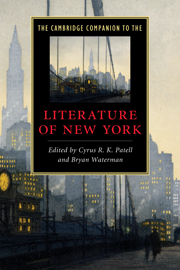Book contents
- Frontmatter
- Introduction
- 1 From British outpost to American metropolis
- 2 Dutch New York from Irving to Wharton
- 3 The city on stage
- 4 Melville, at sea in the city
- 5 Whitman’s urbanism
- 6 The early literature of New York’s moneyed class
- 7 Writing Brooklyn
- 8 New York and the novel of manners
- 9 Immigrants, politics, and the popular cultures of tolerance
- 10 Performing Greenwich Village bohemianism
- 11 African American literary movements
- 12 New York’s cultures of print
- 13 From poetry to punk in the East Village
- 14 Staging lesbian and gay New York
- 15 Emergent ethnic literatures
- Further reading
- Index
- Series list
1 - From British outpost to American metropolis
Published online by Cambridge University Press: 28 November 2010
- Frontmatter
- Introduction
- 1 From British outpost to American metropolis
- 2 Dutch New York from Irving to Wharton
- 3 The city on stage
- 4 Melville, at sea in the city
- 5 Whitman’s urbanism
- 6 The early literature of New York’s moneyed class
- 7 Writing Brooklyn
- 8 New York and the novel of manners
- 9 Immigrants, politics, and the popular cultures of tolerance
- 10 Performing Greenwich Village bohemianism
- 11 African American literary movements
- 12 New York’s cultures of print
- 13 From poetry to punk in the East Village
- 14 Staging lesbian and gay New York
- 15 Emergent ethnic literatures
- Further reading
- Index
- Series list
Summary
In 1828, James Kirke Paulding summarized the changes that New York had undergone since September 1664, when the Dutch had surrendered to the forces of James Stuart, Duke of York. Paulding's account is still disquietingly relevant today:
New York, though a very honest and well-intentioned city as times go, (with the exception of Wall Street, which labours under a sort of a shadow of suspicion,) has changed its name almost as often as some graceless rogues, though doubtless not for the same reasons. The Indian name was Manhadoes; the Dutch called it New Orange and New Amsterdam; the English New York, which name all the world knows it still retains. In 1673, it was a small village, and the richest man in it was Frederick Philipse, or Flypse , who was rated at 80,000 guilders. Now it is the greatest city in the new world; the third, if not the second, in commerce of all the world, old and new; and there are men in it, who were yesterday worth millions of guilders - in paper money: what they may be worth to-morrow, we cant [sic] say, as that will depend on a speculation. In 1660, the salaries of ministers and public officers were paid in beaver skins: now they are paid in bank notes. The beaver skins were always worth the money, which is more than can be said of the bank notes. New York contains one university and two medical colleges . . . twenty-two banks - good, bad and indifferent; forty-three insurance companies - solvent and insolvent; and one public library: from whence it may be reasonably inferred, that money is plenty as dirt - insurance bonds still more so - and that both are held in greater estimation than learning. There are also one hundred churches, and almost as many lottery offices, which accounts for the people of New York being so much better than their neighbours . . . there is an academy of arts, an athenaeum, and several other institutions for the discouragement of literature, the arts and sciences . . . New York supports six theatres, of various kinds: from whence it may be inferred, the people are almost as fond of theatres as churches. There was an Italian opera last year. But . . . the birds are flown to other climes, and left the sweet singers of the nations, as it were, howling in the wilderness.
- Type
- Chapter
- Information
- The Cambridge Companion to the Literature of New York , pp. 10 - 26Publisher: Cambridge University PressPrint publication year: 2010

